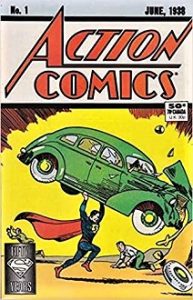
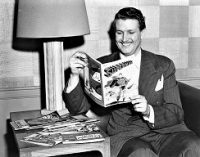 The Adventures of Superman (1940-1951) aired “The Ghost of Billy Baker” on January 7, 1950 as the 11th of 13th episodes of its late 1949–early 1950 season (all of which were of the half hour variety as opposed to the many multi-part, 15-minute serials that ran through most of the 1940s). Since we’ve showcased only one other episode of this program (eight months ago in October of 2020) I felt it would be helpful for newcomers to this fun adventure series if I reprised the generic background information that preceded that other episode.
The Adventures of Superman (1940-1951) aired “The Ghost of Billy Baker” on January 7, 1950 as the 11th of 13th episodes of its late 1949–early 1950 season (all of which were of the half hour variety as opposed to the many multi-part, 15-minute serials that ran through most of the 1940s). Since we’ve showcased only one other episode of this program (eight months ago in October of 2020) I felt it would be helpful for newcomers to this fun adventure series if I reprised the generic background information that preceded that other episode.
The Superman character, created by Jerry Siegel and Joe Shuster, first appeared in Action Comics #1, dated June 1938. That superhero strip in the comic was one of several strips in that now famous first issue, but turned out to be popular enough that a newspaper comic strip debuted in 1939. It also proved immensely popular, popular enough that a stand alone comic book was spun off and added to the ever-growing franchise, with the now iconic title of Superman #1, with a cover date of Summer 1939 (cover below left).
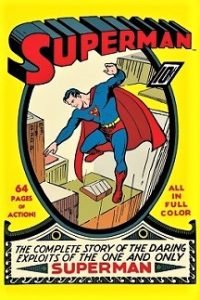 But the comic strip and magazine were only the beginning for the Man of Steel. Things were moving quickly, and as Wikipedia explains: “The serial came to radio as a syndicated show on New York City’s WOR on February 12, 1940. On Mutual, it was broadcast from August 31, 1942, to February 4, 1949, as a 15-minute serial, running three or, usually, five times a week. From February 7 to June 24, 1949, it ran as a thrice-weekly half-hour show. The series shifted to ABC Saturday evenings on October 29, 1949, and then returned to afternoons twice a week on June 5, 1950, continuing on ABC until March 1, 1951. In all, 2,088 original episodes of The Adventures of Superman aired on American radio.” Wikipedia also notes that many of the elements that have become staples of Superman’s fictional world were first introduced in the radio show, among them kryptonite, Daily Planet editor Perry White, copy boy (later cub reporter) Jimmy Olsen, and police inspector Bill Henderson. Also worthy of mention is the first meeting between Superman and Batman (and Robin) which took place in the March 2, 1945 episode.
But the comic strip and magazine were only the beginning for the Man of Steel. Things were moving quickly, and as Wikipedia explains: “The serial came to radio as a syndicated show on New York City’s WOR on February 12, 1940. On Mutual, it was broadcast from August 31, 1942, to February 4, 1949, as a 15-minute serial, running three or, usually, five times a week. From February 7 to June 24, 1949, it ran as a thrice-weekly half-hour show. The series shifted to ABC Saturday evenings on October 29, 1949, and then returned to afternoons twice a week on June 5, 1950, continuing on ABC until March 1, 1951. In all, 2,088 original episodes of The Adventures of Superman aired on American radio.” Wikipedia also notes that many of the elements that have become staples of Superman’s fictional world were first introduced in the radio show, among them kryptonite, Daily Planet editor Perry White, copy boy (later cub reporter) Jimmy Olsen, and police inspector Bill Henderson. Also worthy of mention is the first meeting between Superman and Batman (and Robin) which took place in the March 2, 1945 episode.
Bud Collyer (1908-1969, photo top right)) was the voice of Clark Kent and Superman on radio, lowering his voice slightly when speaking as the Man of Steel. He is arguably best known, however, as the host of the popular television game shows of the 1950s, Beat the Clock and To Tell the Truth.
Joan Alexander (1915-2009, birth name Louise Abrass) played the spunky Lois Lane character for more than one thousand episodes of the program’s 11-year run.
From 1940-47 Jack Kelk (1923-2002) would play Jimmy Olsen, and from 1948-1950 it was Jack Grimes (1926-2009) who would play Jimmy Olsen. An interesting bit of trivia concerning Grimes is that though he was an old man of 22 when he began playing Jimmy Olsen, by the age of 12 he was acting in 35-40 radio shows a week. Grimes also worked in film and television in later years. A film of note in which he appeared was 1945’s noir crime film Lady on a Train (starring Deanna Durbin and Ralph Bellamy), based on the Leslie Charteris story. His television work included roles in Tom Corbett, Space Cadet, Maude, and All in the Family.
(Left: Joan Alexander – Center: Jack Kelk – Right: Jack Grimes)
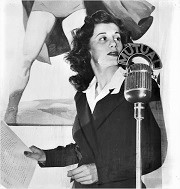

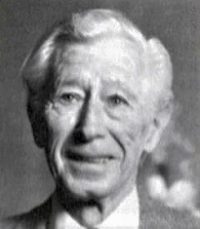
As for “The Ghost of Billy Baker,” Metropolis Daily Planet newspaper editor Perry White has sent Clark and Lois on a seemingly minor assignment to check out recent reports of a haunted coal mine. Following a cursory investigation and about to return to Metropolis with their dead end non-story, things begin to happen to change their minds and they re-open and intensify their investigation in earnest. Strange unexplained occurrences take place and turn into a true mystery, giving credence to what they had believed to be the deranged rantings of an old woman. Is there more that meets the eye beyond the local story about the death of a young man who defied the odds and decided to work the dangerous coal mine after it was declared unsafe? Only by listening to this adventure of Superman will you find out if the dark goings on are really caused by “The Ghost of Billy Baker.”
Play Time: 28:28
{“The Ghost of Billy Baker” aired on the first Saturday in January in 1950, giving the neighborhood gang plenty of time to hit the local newsstand before the weekend ended, giving them time to devour their new purchases before returning to school on Monday. Astounding SF (1930-present, now Analog) was a must buy. Probably the most interesting stories in this issue were “Gypsy” by Poul Anderson, one of his early Psychotechnic League stories, and the 3rd part of 3 of “And Now You Don’t,” one of Isaac Asimov’s Foundation series stories. Astounding, as always, was a monthly in 1950. Other Worlds (1949-53) was yet another relatively short-lived magazine (31 issues) to add to publisher/editor Raymond Palmer’s string of them. As with a number of his other publication enterprises financial problems were at the heart of the magazine’s demise. Though it had its moments here and there with its colorful adventure science-fantasy formula, it never maintained a regular schedule though did manage 7 issues in 1950. Startling Stories (1939-55) was one of the more beloved of the early SF pulp magazines that survived into the 1950s, and was a home for many of the classic authors and their stories, able to attract (among many others) highly popular author favorites like A. E. van Vogt, and none other than Edmond Hamilton the “Galaxy Smasher,” who in this issue would offer one of his famous Captain Future short novels. Though Hamilton’s Captain Future magazine ran for 17 issues from 1940-44, and were written with a very young audience in mind, Hamilton would continue to pound the typewriter with further Curt Newton (aka Captain Future) tales in Startling Stories into the 1950s. While amateurishly written, they were great fun and provided fodder for young readers whose imaginations could never get enough, as the stories whisked them across galaxies and onto many strange worlds, with the most outlandish backdrops and deadly adventures against all kinds of evil (mad genius’s with their super-scientific gadgets, and otherwise). Startling Stories was a bi-monthly in 1950.}
[Left: Astounding, Jan. 1950 – Center: Other Worlds, Jan. 1950 – Right: Startling Stories, Jan. 1950]
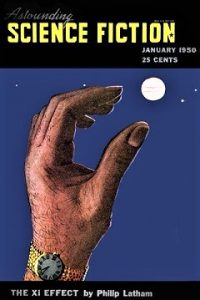
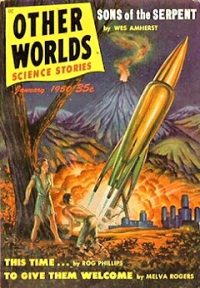
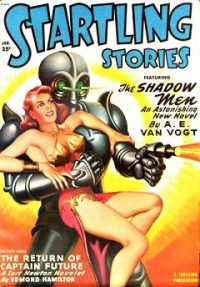
To view the entire list of weekly Old Time Radio episodes at Tangent Online, click here.